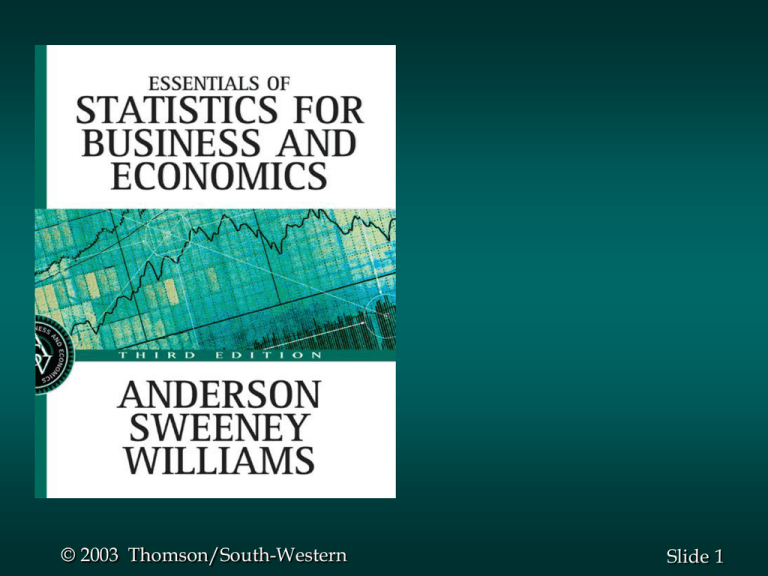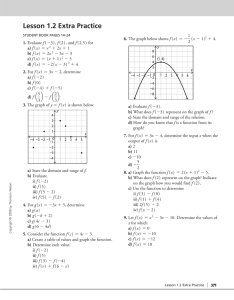© 2003 Thomson/South-Western 1 Slide
advertisement

© 2003 Thomson/South-Western Slide 1 Chapter 3 Descriptive Statistics: Numerical Methods Part A Measures of Location Measures of Variability x © 2003 Thomson/South-Western Slide 2 Measures of Location Mean Median Mode Percentiles Quartiles © 2003 Thomson/South-Western Slide 3 Example: Apartment Rents Given below is a sample of monthly rent values ($) for one-bedroom apartments. The data is a sample of 70 apartments in a particular city. The data are presented in ascending order. 425 440 450 465 480 510 575 430 440 450 470 485 515 575 430 440 450 470 490 525 580 435 445 450 472 490 525 590 435 445 450 475 490 525 600 © 2003 Thomson/South-Western 435 445 460 475 500 535 600 435 445 460 475 500 549 600 435 445 460 480 500 550 600 440 450 465 480 500 570 615 440 450 465 480 510 570 615 Slide 4 Mean The mean of a data set is the average of all the data values. If the data are from a sample, the mean is denoted by x. xi x n If the data are from a population, the mean is denoted by m (mu). xi N © 2003 Thomson/South-Western Slide 5 Example: Apartment Rents Mean xi 34, 356 x 490.80 n 70 425 440 450 465 480 510 575 430 440 450 470 485 515 575 430 440 450 470 490 525 580 435 445 450 472 490 525 590 © 2003 Thomson/South-Western 435 445 450 475 490 525 600 435 445 460 475 500 535 600 435 445 460 475 500 549 600 435 445 460 480 500 550 600 440 450 465 480 500 570 615 440 450 465 480 510 570 615 Slide 6 Median The median is the measure of location most often reported for annual income and property value data. A few extremely large incomes or property values can inflate the mean. © 2003 Thomson/South-Western Slide 7 Median The median of a data set is the value in the middle when the data items are arranged in ascending order. For an odd number of observations, the median is the middle value. For an even number of observations, the median is the average of the two middle values. © 2003 Thomson/South-Western Slide 8 Example: Apartment Rents Median Median = 50th percentile i = (p/100)n = (50/100)70 = 35.5 Averaging the 35th and 36th data values: Median = (475 + 475)/2 = 475 425 440 450 465 480 510 575 430 440 450 470 485 515 575 430 440 450 470 490 525 580 435 445 450 472 490 525 590 435 445 450 475 490 525 600 © 2003 Thomson/South-Western 435 445 460 475 500 535 600 435 445 460 475 500 549 600 435 445 460 480 500 550 600 440 450 465 480 500 570 615 440 450 465 480 510 570 615 Slide 9 Mode The mode of a data set is the value that occurs with greatest frequency. The greatest frequency can occur at two or more different values. If the data have exactly two modes, the data are bimodal. If the data have more than two modes, the data are multimodal. © 2003 Thomson/South-Western Slide 10 Example: Apartment Rents Mode 450 occurred most frequently (7 times) Mode = 450 425 440 450 465 480 510 575 430 440 450 470 485 515 575 430 440 450 470 490 525 580 435 445 450 472 490 525 590 435 445 450 475 490 525 600 © 2003 Thomson/South-Western 435 445 460 475 500 535 600 435 445 460 475 500 549 600 435 445 460 480 500 550 600 440 450 465 480 500 570 615 440 450 465 480 510 570 615 Slide 11 Percentiles A percentile provides information about how the data are spread over the interval from the smallest value to the largest value. Admission test scores for colleges and universities are frequently reported in terms of percentiles. © 2003 Thomson/South-Western Slide 12 Percentiles The pth percentile of a data set is a value such that at least p percent of the items take on this value or less and at least (100 - p) percent of the items take on this value or more. • Arrange the data in ascending order. • Compute index i, the position of the pth percentile. i = (p/100)n • If i is not an integer, round up. The pth percentile is the value in the ith position. • If i is an integer, the pth percentile is the average of the values in positions i and i+1. © 2003 Thomson/South-Western Slide 13 Example: Apartment Rents 90th Percentile i = (p/100)n = (90/100)70 = 63 Averaging the 63rd and 64th data values: 90th Percentile = (580 + 590)/2 = 585 425 440 450 465 480 510 575 430 440 450 470 485 515 575 430 440 450 470 490 525 580 435 445 450 472 490 525 590 435 445 450 475 490 525 600 © 2003 Thomson/South-Western 435 445 460 475 500 535 600 435 445 460 475 500 549 600 435 445 460 480 500 550 600 440 450 465 480 500 570 615 440 450 465 480 510 570 615 Slide 14 Quartiles Quartiles are specific percentiles First Quartile = 25th Percentile Second Quartile = 50th Percentile = Median Third Quartile = 75th Percentile © 2003 Thomson/South-Western Slide 15 Example: Apartment Rents Third Quartile Third quartile = 75th percentile i = (p/100)n = (75/100)70 = 52.5 = 53 Third quartile = 525 425 440 450 465 480 510 575 430 440 450 470 485 515 575 430 440 450 470 490 525 580 435 445 450 472 490 525 590 435 445 450 475 490 525 600 © 2003 Thomson/South-Western 435 445 460 475 500 535 600 435 445 460 475 500 549 600 435 445 460 480 500 550 600 440 450 465 480 500 570 615 440 450 465 480 510 570 615 Slide 16 Measures of Variability It is often desirable to consider measures of variability (dispersion), as well as measures of location. For example, in choosing supplier A or supplier B we might consider not only the average delivery time for each, but also the variability in delivery time for each. © 2003 Thomson/South-Western Slide 17 Measures of Variability Range Interquartile Range Variance Standard Deviation Coefficient of Variation © 2003 Thomson/South-Western Slide 18 Range The range of a data set is the difference between the largest and smallest data values. It is the simplest measure of variability. It is very sensitive to the smallest and largest data values. © 2003 Thomson/South-Western Slide 19 Example: Apartment Rents Range Range = largest value - smallest value Range = 615 - 425 = 190 425 440 450 465 480 510 575 430 440 450 470 485 515 575 430 440 450 470 490 525 580 435 445 450 472 490 525 590 435 445 450 475 490 525 600 © 2003 Thomson/South-Western 435 445 460 475 500 535 600 435 445 460 475 500 549 600 435 445 460 480 500 550 600 440 450 465 480 500 570 615 440 450 465 480 510 570 615 Slide 20 Interquartile Range The interquartile range of a data set is the difference between the third quartile and the first quartile. It is the range for the middle 50% of the data. It overcomes the sensitivity to extreme data values. © 2003 Thomson/South-Western Slide 21 Example: Apartment Rents Interquartile Range 3rd Quartile (Q3) = 525 1st Quartile (Q1) = 445 Interquartile Range = Q3 - Q1 = 525 - 445 = 80 425 440 450 465 480 510 575 430 440 450 470 485 515 575 430 440 450 470 490 525 580 435 445 450 472 490 525 590 435 445 450 475 490 525 600 © 2003 Thomson/South-Western 435 445 460 475 500 535 600 435 445 460 475 500 549 600 435 445 460 480 500 550 600 440 450 465 480 500 570 615 440 450 465 480 510 570 615 Slide 22 Variance The variance is a measure of variability that utilizes all the data. It is based on the difference between the value of each observation (xi) and the mean (x for a sample, for a population). © 2003 Thomson/South-Western Slide 23 Variance The variance is the average of the squared differences between each data value and the mean. If the data set is a sample, the variance is denoted by s2 . s2 2 ( x x ) i n 1 If the data set is a population, the variance is denoted by 2. 2 ( x ) i 2 N © 2003 Thomson/South-Western Slide 24 Standard Deviation The standard deviation of a data set is the positive square root of the variance. It is measured in the same units as the data, making it more easily comparable, than the variance, to the mean. If the data set is a sample, the standard deviation is denoted s. s s2 If the data set is a population, the standard deviation is denoted (sigma). © 2003 Thomson/South-Western 2 Slide 25 Coefficient of Variation The coefficient of variation indicates how large the standard deviation is in relation to the mean. If the data set is a sample, the coefficient of variation is computed as follows: s (100) x If the data set is a population, the coefficient of variation is computed as follows: (100) © 2003 Thomson/South-Western Slide 26 Example: Apartment Rents Variance s n 1 2 ( xi x ) 2 2 , 996.16 Standard Deviation s s2 2996. 47 54. 74 Coefficient of Variation s 54. 74 100 100 11.15 x 490.80 © 2003 Thomson/South-Western Slide 27 End of Chapter 3, Part A © 2003 Thomson/South-Western Slide 28







